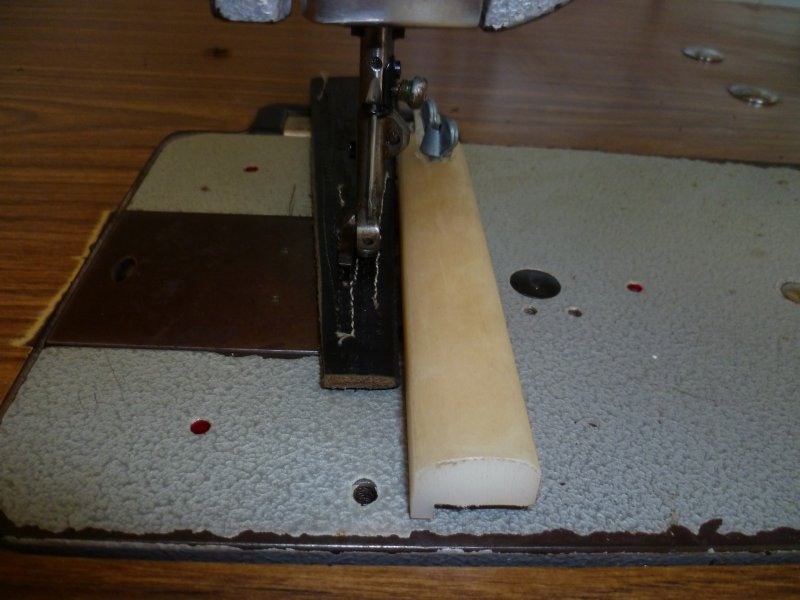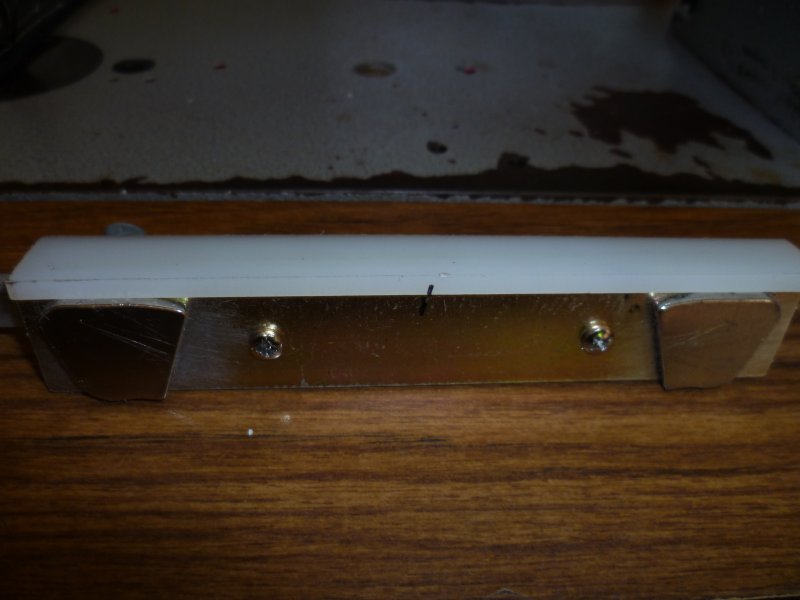-
Posts
4,810 -
Joined
-
Last visited
Content Type
Profiles
Forums
Events
Blogs
Gallery
Everything posted by dikman
-
There's been a few posts about those machines, and for what they are they're not bad. The fishing line stitching looks good, but I have to admit I'm surprised you got it to work. These machines are best with #69 thread, and even with that the bobbin is small. Still, good fun to play around with and can get into pretty tight areas.
-
My next project is a set of holsters and gunbelts, which the lady wants in a walnut brown - not as easy as I thought. I bought Fiebings Medium Brown, but I would call it Very Dark Brown! It also has red in it, which becomes more obvious if I cut the strength, but she doesn't want any red tinging. So I bought Fiebings Light Brown, but it's still a dark brown and shows red tinging on the edges of a test piece. So, how do I get a proper brown colour? I'm in the process of making my own walnut stain (from walnuts) but trying to get it dark enough is a bit of a challenge, so I'm still working on it. Any ideas?
-
That makes a change from the usual black/silvery grey hammertone/beige. Now that you've mastered the photo thing, how about a couple of the rear and underside of the table and motor? Might give me a few ideas.
-
Nice one, Nick! . As for the photos, you just need to resize them (smaller). I use irfanview, it's free and has default settings for resizing - easy. Uwe, that photo has got me thinking (bit dangerous). My Pfaff 335 is fitted to a normal table, but now I'm wondering about making something like the photo as it would save a bit of room in my shed.
-

Edge Guide for Consew 225 (and clones)
dikman replied to KeithHideWorks's topic in Leather Sewing Machines
NC, the wood looks nice. Now, as for the rest of the machine..... Sark, yep, I agree, a screw-attached fitting would be the better choice. The problem I have is that I have several different machines I may need to fit an edge guide to and after much pondering and fiddling I figured the magnetic type would allow me to shift one guide between several machines. Uwe, thanks for ripping open the knife holder, I have, for some time, been curious what they were made of. -
There are a few advertisers/sponsors that advertise here, probably be a good place to start looking for a servo.
-

Edge Guide for Consew 225 (and clones)
dikman replied to KeithHideWorks's topic in Leather Sewing Machines
Switchable magnets would certainly be easier to use and those that northmount linked to would probably be easier to adapt to a guide. Keith, if that magnet is a bit strong try putting a few layers of tape on the bottom, that should reduce its "grab" a bit. I wouldn't worry about the magnetic field affecting other parts of the machine, as once it's clamped to the metal base that should contain the field and stop it extending beyond where it's clamped. I think I need to figure out some sort of fitting on mine so that I can easily break the magnetic contact to remove it, as using a screwdriver to lever it isn't very elegant. -

Edge Guide for Consew 225 (and clones)
dikman replied to KeithHideWorks's topic in Leather Sewing Machines
Thanks for the ideas, folks, this is my version. I have plenty of old hard drive magnets but unfortunately they don't have convenient screw holes in them, so I used a small steel bar and super-glued two to it. Rather than wood I used a piece of hard nylon that I had and milled the sides flat and a rebate in the bottom for the bar. I had already made a guide roller for a different fitting so I milled a groove in the top and screwed it to the nylon. (I have to use a screwdriver to lever the bar from the machine base to move it!!!). -
Good idea, don't rush into it. Nothing wrong with hand stitching (other than the time it takes to do a belt!!). There is a lot to learn about industrial machines so keep reading. As Uwe said, buying a new machine (while the initial cost is higher) means you have a machine that will work with minimal issues. Buying used means you will probably either have to pay to have it checked/serviced or learn how to fix it yourself (assuming you haven't bought a complete lemon). That Juki, by the way, should be more than adequate to sew belts. So have patience, keep reading and don't be afraid to ask questions.
-
" de-criticalizes "??
-
I just bought a Seiko, it looks the same as the one Sark posted. Based on my experience it's definitely the preferred choice. Mine easily handles up to 138 thread and will go through whatever I can fit under the foot. A beautiful machine. Plus that one on CL comes with a servo, which is even better! I drove for an hour across town for mine and it was worth it. Consew is the brand name that Seiko use for the American market, so essentially the same machine.
-

Sewing lightweight leather without a walking foot ?
dikman replied to littlewing6283's topic in Leather Sewing Machines
You mentioned silicone spray, personally I wouldn't use it as the last thing you want is silicone contaminating your leather. -
My Irish isn't too good, is that price 10 Euros for the set? If so that's about AUS$14!!!!!
-
At the risk of boring people, I have to make one more statement - I love this machine!! I have some M20/138 bonded braided polyester thread and none of my machines like it, they inevitably catch the braiding at some point during stitching and usually after a very few stitches. I gave up trying to get the adjustments right. So, out of curiosity I decided to try it in the Seiko. Perfect first time, no tweaking necessary. Don't know why it won't work on the others but does on this one, but I don't really care. I'm very impressed.
-

Anyone Tried this Speed Reducer?
dikman replied to KeithHideWorks's topic in Leather Sewing Machines
Yetibelle, that's not a bad solution, as it's easier working on these things from up top rather than clambering around underneath! Just make sure that it doesn't interfere with tilting the head back. On of mine is mounted underneath but in order to tilt the head back I have to slacken the speed reducer first (no big deal but it is annoying). -
The knob generally sets the max speed and the foot control will then operate within that range (0 to whatever). Make sure you fit the smallest pulley you can to the motor (I've got 45 mm / 1 3/4") as it all helps.
-

Anyone Tried this Speed Reducer?
dikman replied to KeithHideWorks's topic in Leather Sewing Machines
Sorry mate, I just realised that your machine is probably similar to my 211G166 and in order to fit a replacement pulley on the head unit a sleeve will have to be fitted around the shaft and fit inside the body of the machine which Is why I haven't done it to my 211 (yet). On most machines there is a bushing/bearing fitted inside the pulley end of the main body and the shaft fits through it. The 211 is different and the pulley (handwheel) is machined to fit over the shaft and extends inside the main body. If you try replacing the pulley then the main shaft can oscillate unless it has this sleeve fitted. Use the 8" in place of the 5", you should have the room there and it will still make a difference. -
Thanks guys. I think the lower oil tank is leaking, probably just needs new gasket material. I'm also thinking of fitting a handle/knob to the large pulley as this would make it easier to handcrank it.
-
Almost done, just have to sort out the knee lifter. The tabletop came with it so I re-used it but fitted it to stronger legs (the kneelifter positioning is different to the Singers so it was easier to use the original table rather than drop it onto a Singer table).The motor has a 1 3/4" pulley so fitting an 8" on the head unit gives me a 1:4.4 reduction, and coupled with the servo I can crawl it nicely with lots of torque. I just need to replace the belt with a smaller cross-section one, as while this one works I think it's a bit too stiff. (Since I started this sewing machine thing I've accumulated quite a selection of belts but I never seem to have the size I need ).
-
Doh, thanks Uwe, you're quite right, of course. Don't know how I missed that (and I even had my glasses on!). I saw the red bit and thought it was an LCD display. That reduces its value straight away .
-

Anyone Tried this Speed Reducer?
dikman replied to KeithHideWorks's topic in Leather Sewing Machines
Nice job! Now, replace that 5" pulley with an 8" and fit a larger pulley on the head unit (replace the handwheel) and I reckon you might not need a servo. It will also have gobs of torque. -
Hooked it up to a motor and tried a run down an old belt with #138 thread - beautiful, didn't miss a beat. Two pieces of scrap veg, just over 1/4" thick, and it treated it like a very thin piece, perfect stitches. I've got no doubt this thing will sew whatever I can fit under the feet. And I reckon it might handle #207, just a pity I haven't got any to try. Me happy , me like . Now I think I know why folks like their Seikos/Consews so much.
-

Anyone Tried this Speed Reducer?
dikman replied to KeithHideWorks's topic in Leather Sewing Machines
Holsters are arguably one of the toughest things to sew, due to thickness, so a slow speed with good torque is needed. I'm puzzled why you can't adjust the speed any slower (my servos can be set to almost a crawl just by themselves). Fit the smallest pulley you can to the motor, generally 2", and a speed reducer will definitely help as it will give more torque at low speed. The big machines have a small pulley on the motor and a (very) large pulley on the head unit. I did this on my Pfaff (fitted an 8" on the head) and it gives excellent slow speed control + torque. Some of the big machines will also have a speed reducer fitted as this combination gives an incredible amount of grunt to let them punch through very thick leather. By all means fit the speed reducer, as it won't do any harm, but you really have to get that servo running slower too. -
I'm not familiar with pricing over there, but I'd guess it's at the upper end for a machine like this? Looks pretty good, though, no paint missing from the bed, still has the needle protection bar fitted (I've yet to see a used machine that still has it!) and has a servo, with remote adjuster at the front of the table. I'd guess that having a servo would bump the price up a bit. As it's a company selling it it's probably not going to be a bargain buy, but it still might be a good buy.







